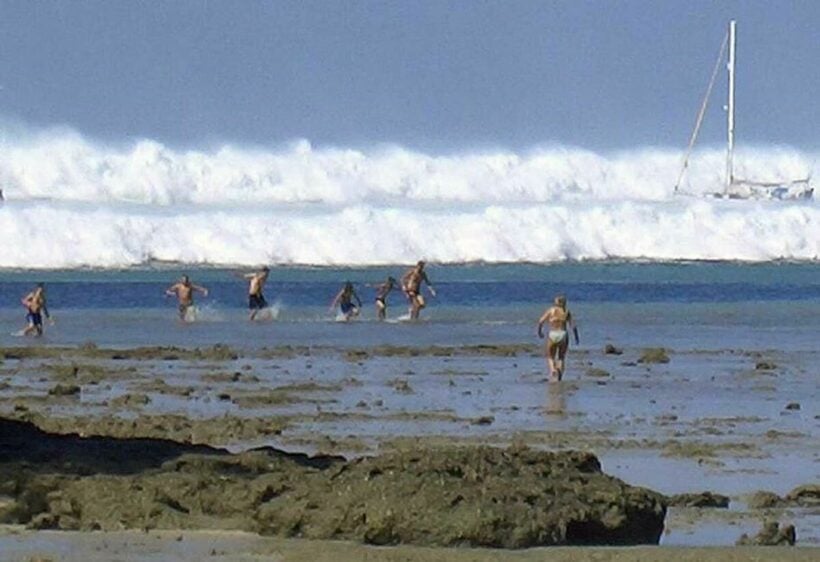Thailand – the 17th anniversary of the Indian Ocean Tsunami

A powerful underwater earthquake rumbled off the coast of northern coast of Sumatra island, Indonesia, at 7:59am local time, setting off a series of underwater shockwaves that would eventually be felt right around the rim of the Indian Ocean.
It was the Boxing Day Tsunami (or Indian Ocean Tsunami, or Asian Tsunami) and it started affecting the shorelines around the Indian Ocean, first in the Indonesian region of Aceh, and then Thailand’s southern Andaman Sea shores not long after on Sunday morning, December 26, 2004.
The magnitude 9.1 quake ruptured a 1,500-kilometre stretch of fault line where the Indian and Australian tectonic plates meet. The heavier ocean plate slipped under a lighter continental plate. The effect, and location, proved deadly for anyone living along the shorelines of the Indian Ocean.
Within 20 minutes of the earthquake, the first of several 22 – 33 metre high waves hit the shoreline of Banda Aceh, killing 100,000+ people. Then, in succession, waves rolled over coastlines in Thailand, India and Sri Lanka, killing tens of thousands more. 8 hours later and 8,000 kilometres from its Asian epicentre, the tsunami claimed its final casualties on the coast of South Africa. In all, 230,000 – 250,000 people died, or were never found, making it one of the deadliest natural disasters in recorded history.
The tsunami reached Phuket and coastal provinces nearby around 10am, causing uncountable losses, devastating the low-lying coastal towns of Patong, Kamala and Koh Phi Phi. Some of the other island beaches had less damage with steep shoreline breaks that took a lot of the initial energy out of the waves.
Just north of Phuket, in Khao Lak, they had a very gentle sloping coastline, so the waves travelled swiftly and reached into areas up to kilometre inshore. Poom Jensen, the grandson of the late King Bhumibol Adulyadej, and a nephew of the current Thai King, was killed whilst his family was holidaying at Khao Lak.
3 large waves that swept inland along parts of the Andaman Coast on that day.
Official Thai government statistics estimate 4,812 souls were lost to the waves on December 26, 2004, with another 8,457 injured and 4,499 missing, presumed dead.
While confirmed deaths in Phuket officially numbered only 259, another 700 remained listed as missing.
At the time the popular tourist communities were able to clean up and re-open some of their hotels within weeks. A year later much of the damage had been cleaned up and repaired. NGOs rushed to Thailand to assist in the clean up and identification process of the dead.
The tsunami and its aftermath were responsible for immense destruction and loss around the rim of the Indian Ocean. Some locations reported that the waves had reached a height of 20 metres, or more, when they hit the shoreline. In Aceh, up to 30 metres. Indonesia, Sri Lanka, India, Maldives and Thailand sustaining massive damage.
17 years after the Indian Ocean tsunami swept ashore, a container at the Takua Pa police station in Phang Nga, southern Thailand, still contains personal items from the hundreds of victims whose remains are unlikely to ever be given a name.
Wallets, documents, keys, electronic items, all labeled and catalogued as evidence, await positive identification. Nearby a graveyard contains 340 bodies buried in unmarked graves but police hope that, if people came forward to identify some of the items, there is still hope that some of the bodies could rest in peace with a name attached.
Here’s a story about the maintenance of the Tsunami Warning bouys.
Fast facts: 2004 Indian Ocean earthquake and tsunami
• The Sumatra-Andaman earthquake, which caused the 2004 Indian Ocean tsunami, is estimated to have released energy equivalent to 23,000 Hiroshima-type atomic bombs
• In Banda Aceh, the landmass closest to the quake’s epicentre, tsunami waves topped 100 feet (30 metes)
• The tsunami’s waves traveled across the Indian Ocean at 500 mph, the speed of a jet plane
• The 2004 Indonesia earthquake caused a shift in the Earth’s mass that changed the planet’s rotation
• Total material losses from the tsunami were estimated at US$10 million
SOURCE: WorldVision
Latest Thailand News
Follow The Thaiger on Google News:


























